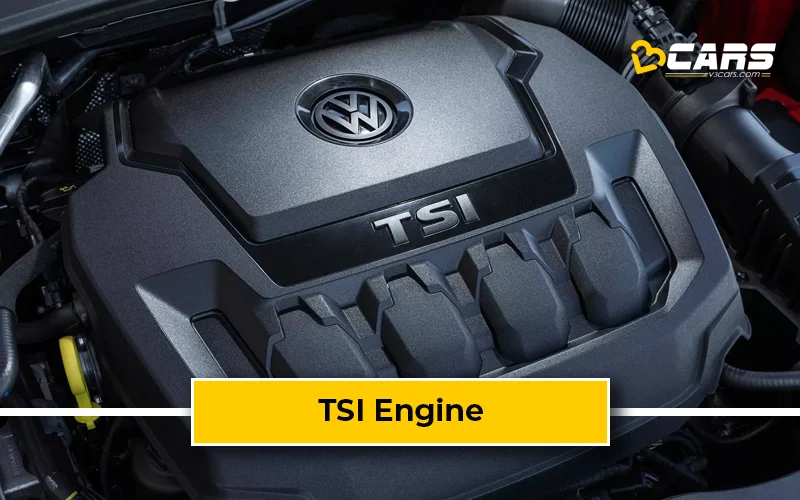What Is TSI Engine In Car And How Does It Work? - Feature Explained
TSI stands for Turbocharged Stratified Injection, and it's a cutting-edge engine technology designed to deliver both powerful performance and impressive fuel efficiency. This combination makes TSI engines a compelling choice for modern car buyers in India. Let's delve into the world of TSI engines, explore their workings, advantages and disadvantages, and how they stack up in the Indian car market.

What Is A TSI Engine In A Car?
A TSI engine combines 2 key technologies:
- Turbocharging: This system forces air into the engine at a higher pressure, allowing for more fuel to be burned and ultimately generating more power.
- Stratified Injection: This fuel injection technology delivers fuel directly into the engine cylinder, optimising the fuel-air mixture for better combustion and improved fuel efficiency.
In essence, TSI engines offer the thrill of turbocharged power without sacrificing fuel economy.
While VW’s TSI technology is a trademarked term for their turbocharged, direct-injection petrol engines, other carmakers use similar technologies, often with their own branding, such as Ford’s EcoBoost, BMW’s TwinPower Turbo, and Honda’s Turbo.
Ford EcoBoost: Ford’s term for their line of small, turbocharged petrol engines
BMW TwinPower Turbo: BMW’s term for their turbocharged engines, which often feature a combination of technologies like direct injection and variable valve timing
Honda Turbo: Honda’s term for their turbocharged petrol engines
Hyundai Turbo GDI: Hyundai use the term “Turbo” or “Turbo GDI” for their turbocharged petrol engines with direct injection
Kia’s T-GDI: Kia uses the term “Turbo” or “T-GDI” for their turbocharged petrol engines with direct injection
Tata Revotron: Tata use the term “Revotron” for their turbocharged petrol engines
Mahindra mStallion: Mahindra use the term “mStallion” for their turbo petrol engines
How Does A TSI Engine In A Car Work?
Here's a simplified breakdown of the TSI engine process:
- Air Intake: Air enters the engine through the air intake system.
- Turbocharging: The turbocharger compresses the incoming air, forcing more air into the engine cylinders.
- Stratified Injection: Fuel is precisely injected directly into the cylinders, considering factors like engine load and driving conditions.
- Combustion: The compressed air-fuel mixture ignites, generating power that drives the engine.
The combination of turbocharging and stratified injection allows TSI engines to achieve a balance between power and efficiency.
Pros And Cons Of TSI Engines
Here are the pros, or advantages, of TSI engine in a car:
- Enhanced Performance: TSI engines offer more power and acceleration compared to naturally aspirated engines of similar size.
- Improved Fuel Economy: The efficient fuel injection process in TSI engines helps reduce fuel consumption and running costs.
- Eco-friendliness: By using less fuel, TSI engines contribute to lower emissions, making them a more environmentally friendly choice.
- Driving Pleasure: The combination of power and efficiency delivers a more responsive and enjoyable driving experience.
Here are the cons, or disadvantages, of a TSI engine:
- Higher upfront cost: Cars equipped with TSI engines tend to be more expensive than those with naturally aspirated engines.
- Potential for higher maintenance costs: TSI engines have more complex components like turbochargers, which may require specialised maintenance or repairs.
- Reliance on high-quality fuel: For optimal performance and longevity, TSI engines typically require high-octane fuel, which is slightly more expensive.
What Is The Repair Or Replacement Cost Of A TSI Engine in India?
The cost of repairing or replacing a TSI engine in India depends on the severity of the damage and the specific car model. Here's a general idea:
- Minor repairs: Minor repairs to a TSI engine could cost anywhere from Rs. 5,000 to Rs. 10,000.
- Major repairs or replacements: For significant issues like turbocharger failure, repairs can be expensive, potentially exceeding Rs. 50,000 depending on the car and parts required.
- Engine replacement: Replacing an entire TSI engine can be a very costly proposition, ranging from Rs. 1.0 lakh to Rs. 3.0 lakh or more.
It's important to note that these are estimated figures, and actual costs can vary. Regular maintenance and using high-quality fuel can help extend the life of your TSI engine and minimise repair needs.
List Of Cars In India With TSI Engine
TSI petrol engines are produced by the Volkswagen Group and can be found on cars sold in India by Volkswagen, Skoda, and Audi:
- Volkswagen: Virtus, Taigun, Tiguan
- Skoda: Slavia, Kushaq, Kodiaq
- Audi: A4, A5, Q3, Q5, Q7
Older and discontinued models such as the Volkswagen Polo and Vento, Skoda Fabia and Rapid, Audi A3, etc. too offered TSI petrol engines.
Is A TSI Engine Right For You?
TSI engines offer a compelling combination of performance and fuel efficiency. However, the higher initial cost and potential for expensive repairs are factors to consider. If you prioritise power and driving pleasure, and you're willing to invest in a car with a potentially higher maintenance cost, a TSI engine can be a great choice. For budget-conscious buyers who prioritise fuel efficiency and running costs above all else, a naturally aspirated petrol engine might be a more suitable option. Ultimately, the decision depends on your individual needs and driving preferences.
Note: Check your Car EMI with our - Car Loan EMI Calculator
You can use our Fuel Cost Calculator to see how much any petrol, diesel or CNG car will cost to run based on the latest fuel price in your city.


0 Comments
Audi Cars in India
RS Q8
₹2.49 Cr*
*Ex-showroom priceQ7
₹88.66 - ₹97.81 lakh*
*Ex-showroom priceQ8
₹1.17 Cr*
*Ex-showroom priceS5
₹75.80 lakh*
*Ex-showroom priceQ8 E-Tron
₹1.15 - ₹1.27 Cr*
*Ex-showroom priceQ8 E-Tron
Sportback
₹1.19 - ₹1.32 Cr*
*Ex-showroom priceQ3 Sportback
₹54.22 lakh*
*Ex-showroom priceRS E-Tron
GT
₹1.95 Cr*
*Ex-showroom priceQ3
₹43.81 - ₹53.17 lakh*
*Ex-showroom priceA6
₹64.09 - ₹70.44 lakh*
*Ex-showroom priceA4
₹45.34 - ₹57.11 lakh*
*Ex-showroom priceQ5
₹65.51 - ₹72.30 lakh*
*Ex-showroom priceUpcoming Audi Cars
RS3
₹85.00 lakh*
*Expected PriceExpected Launch Jan 2027
Latest Audi Cars Videos
Living with Audi Q5 | Long Term Review | Pros & Cons | Expectation vs Reality
Why Are Luxury Cars Better EVs? | 2000km Review of Audi Q8 e-tron | 400km Range, Smart Braking
Audi Q3 Sportback Practicality Test | Rear Seat & Boot Space Review | Buy Q3 or Q3 Sportback?
Mumbai-Delhi Expressway Drive via Statue of Unity in Audi Q7 | Travelogue | March 2023
2 din mein Audi e-tron ko bina charge kiye xxxkm chalaya! | Detailed Review w/ Electric Range Test
Audi Q7 Petrol Review | 0-100, Fuel Efficiency, Third Row Space | The Sensible Review | Dec 2022
2022 Audi Q5 Rear Seat & Boot Space Review | How Comfortable Is It? | The Sensible Review
A4 Important Links